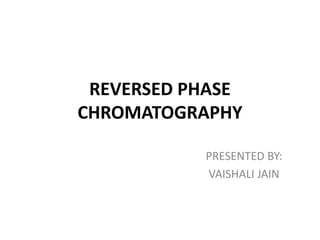
RPC Chromatography Guide
- 2. INTRODUCTION • RPC has become increasingly important for high resolution separation and analysis of proteins, peptides and nucleic acids. • This technique is ideal for applications such as peptide mapping or purity checking and is often used for final polishing of oligonucleotides and peptides. • RPC is often combined with other chromatographic methods to achieve identification and characterisation of proteins and peptides.
- 3. PRINCIPLE • RPC separates molecules according to differences in their hydrophobicity. • Stationary phase: hydrophobic • Mobile phase: polar
- 5. MATRIX • Medium consists of hydrophobic ligands chemically grafted to a porous, insoluble beaded matrix. • The matrix must be both chemically and mechanically stable. • The base matrix for the generally composed of silica or a synthetic organic polymer such as polystyrene.
- 6. • Silica was the first polymer used as the base matrix • Produced as porous beads which are chemically stable at low pH and in the organic solvents. • The chemistry of the silica gel allows simple derivatisation with ligands of various carbon chain lengths. • DISADVANTAGE: Chemical instability in aqueous solutions at high pH. Not recommended for prolonged exposure above pH 7.5.
- 7. • Synthetic organic polymers, e.g. beaded polystyrene, are also available as reversed phase media. • ADVANTAGE: Stable at all pH values in the range of 1 to 12.
- 8. LIGANDS • The selectivity of the reversed phase medium is predominantly a function of the type of ligand grafted to the surface of the medium. • Generally linear hydrocarbon chains (n-alkyl groups) are the most popular ligands used. • The more hydrophobic the molecule to be purified, the less hydrophobic the ligand needs to be.
- 9. END CAPPING • Steric hindrance caused by C18 and C8 reagents prevents complete derivatisation of all the available silanol groups. The residual silanol groups are responsible for the deleterious mixed mode ion exchange effects. • To prevent this, the residual silanol groups are reacted with smaller alkylsilane reagents (chlorotrimethyl- and chlorotriethylsilanes).
- 10. MOBILE PHASE ORGANIC MODIFIERS: • The organic solvent (modifier) is added to lower the polarity of the aqueous mobile phase. The lower the polarity of the mobile phase, the greater its eluting strength. • Must be miscible in water. • UV transparent • Boiling point must be sufficiently low.
- 12. • ION PAIRING AGENTS: To increase the hydrophobicity of charged components, enhance binding to the medium, and so alter retention time. • These agents bind via ionic interactions with charged groups and thereby suppress their influence on overall hydrophobicity. • TFA for positively charged and triethylamine for negatively charged molecules.
- 13. Mixed mode retention &Ion suppression • Preventing mixed mode retention: End-capping Column ageing Addition of trifluroacetic acid Low pH environment
- 14. ELUTION GRADIENT ISOCRATIC Most frequently for preparative and analytical, high-resolution separations of proteins and peptides, in order to minimize separation times. Involve 2 mobile phases. Mainly for high- resolution analysis of small organic molecules, but can occasionally be used to advantage as part of an optimized separation, also for desalting sample. Only one eluent is used.
- 15. GRADIENT ELUTION
- 18. RESOLUTION • Resolution (Rs) is defined as the distance between peak maxima compared with the average base width of the two peaks.
- 19. EFFICIENCY • Column efficiency is the ability to elute narrow, symmetrical peaks from a packed bed. • It relates to the zone broadening that occurs on the column. • Zone broadening can be minimized by minimizing distances available for diffusion. • A well packed column will contribute significantly for resultion.
- 21. SELECTIVITY • Selectivity is the degree of separation between peaks.
- 22. CRITICAL PARAMETERS • Pore size • Temperature • Column length • Flow rate
- 23. BINDING CAPACITY • The binding capacity of an RPC medium is a quantitative measurement of its ability to bind sample components under defined static conditions. • The dynamic binding capacity is a measure of the available binding capacity at a specific flow rate. • Porosity is a crucial factor in determining the binding capacity.